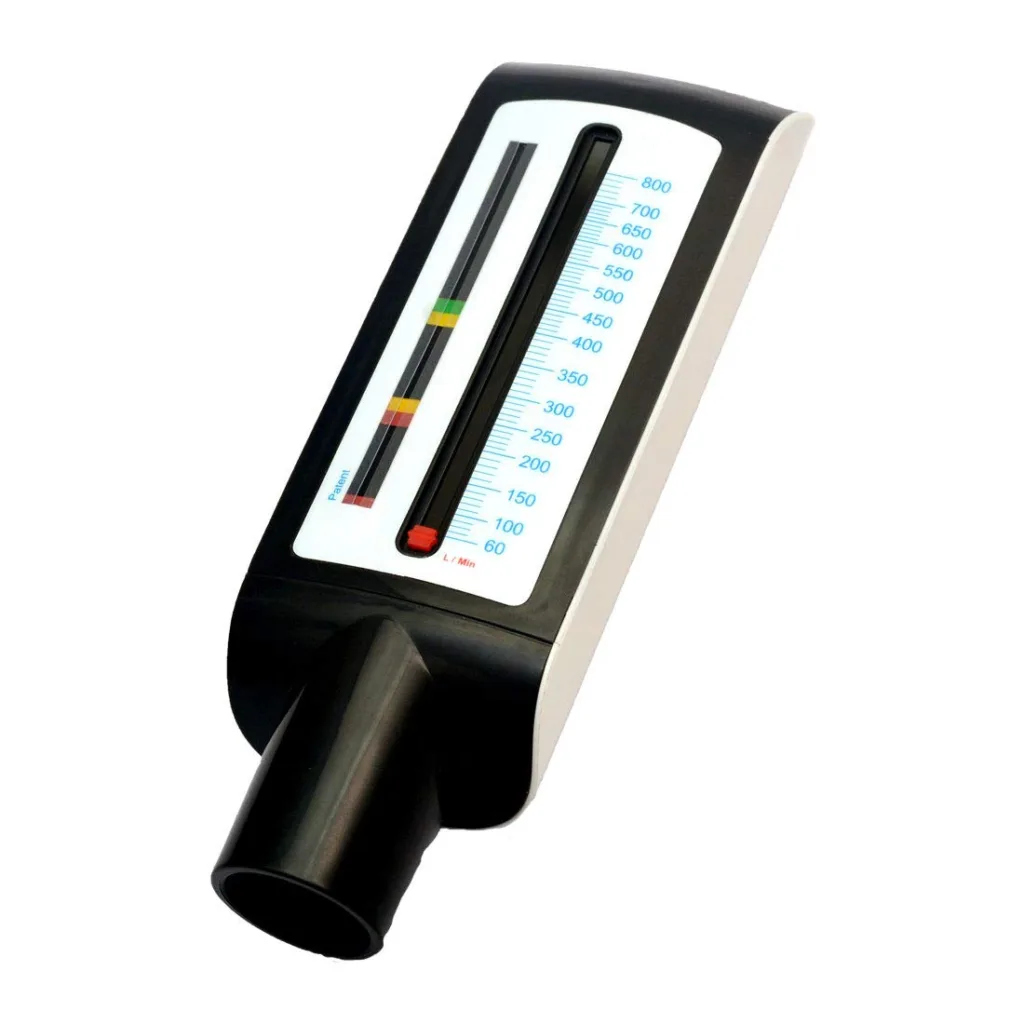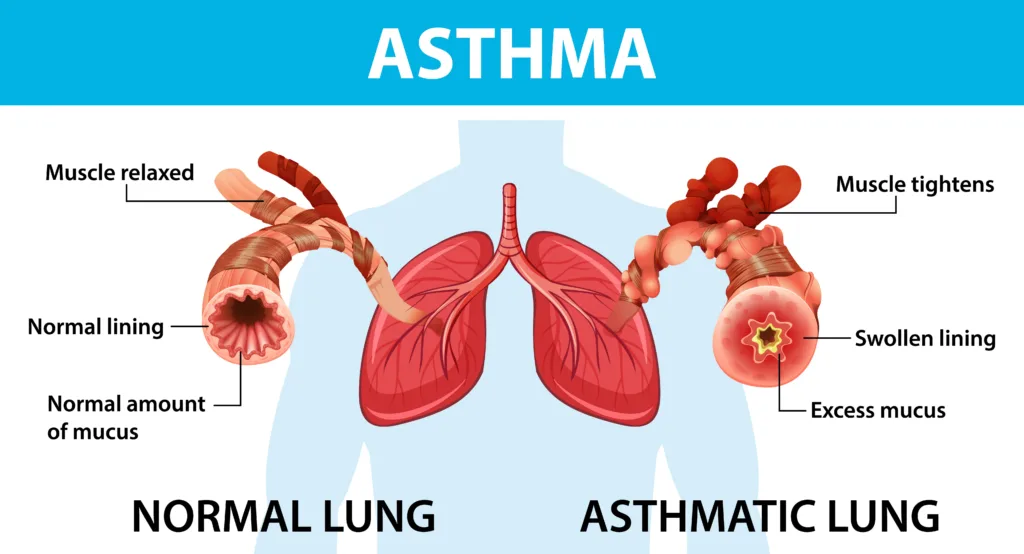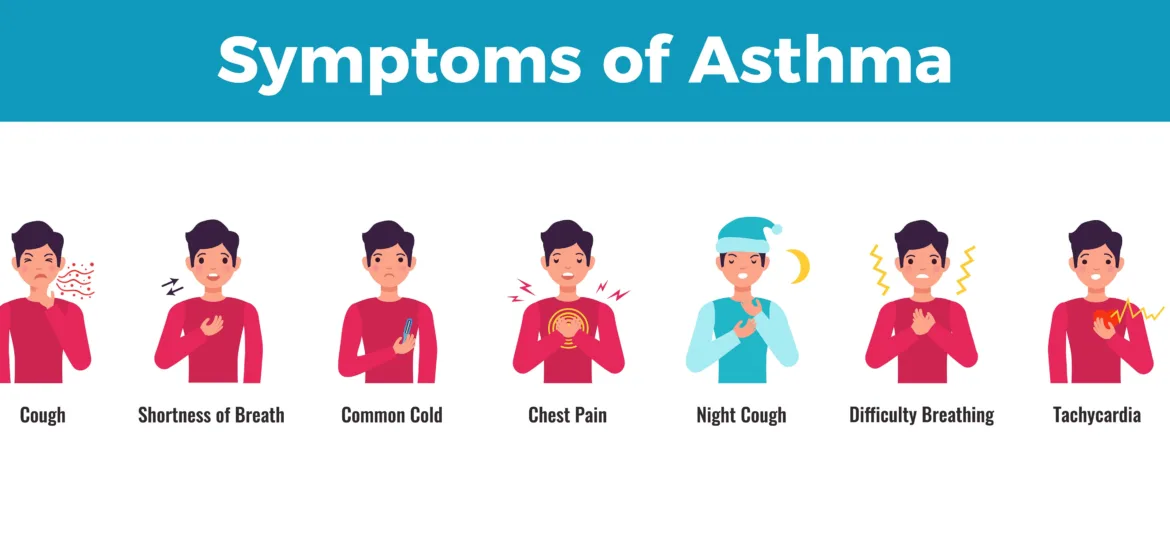What Is Asthma?
Asthma is a worst condition so called long-term disease of the lungs. It causes your airways to get inflamed and narrow, and it makes it hard to breathe. Severe asthma can cause trouble talking or being active. It is a chronic respiratory disease. It is referred as “bronchial asthma” also. As per medical research and history, asthma is a serious disease that affects about 25 million Americans and causes nearly 1.6 million emergency room visits every year. With proper treatment, we can live well. But without proper treatment, we might have to go to the ER often or stay at the hospital, which can affect our daily life.
What Does Asthma Feel Like?
Asthma is marked by inflammation of the bronchial tubes, with extra sticky secretions inside the tubes. People with asthma have symptoms when the airways tighten, inflame, or fill with mucus.
There are three major signs of asthma:
Airway blockage – When we breathe as usual easy going, the bands of muscle around our airways are relaxed, and air moves freely. But when we have asthma, the muscles tighten. It’s harder for air to pass through.
Inflammation – Asthma causes red, swollen bronchial tubes in our lungs. This inflammation can damage our lungs. Treating this is key to managing asthma in the long run.
Airway irritability- People with asthma have sensitive airways that tend to overreact and narrow when they come into contact with even slight triggers.
These problems may cause symptoms such as:
Coughing, especially at night or in the morning, Wheezing, a whistling sound when you breathe
Shortness of breath, Tightness, pain, or pressure in your chest, Trouble sleeping because of breathing problems.
Not every person with asthma has the same symptoms in the same way. You may not have all of these symptoms, or you may have different symptoms at different times.
Some people with asthma may go for long periods without having any symptoms. Others might have problems every day. In addition, some people may have asthma only during exercise or with viral infections like colds.
Mild asthma attacks are generally more common. Usually, the airways open up within a few minutes to a few hours. Severe attacks are less common but last longer and require medical help right away. It is important to recognize and treat even mild asthma symptoms to help you prevent severe episodes and keep asthma under better control.
Now it is important to know when we should see our doctor.
Get medical help right away if you have serious symptoms including:
Fast breathing, Pale or blue face, lips, or fingernails, The skin around your ribs pulls inward when you breathe in, Trouble breathing, walking, or talking, Symptoms that don’t get better even after taking medication.
How Is Asthma Classified?
Doctors rank how bad asthma is by its symptoms:
Mild intermittent asthma. Mild symptoms less than twice a week. Nighttime symptoms less than twice a month. Few asthma attacks.
Mild persistent asthma. Symptoms three to six times a week. Nighttime symptoms three to four times a month. Asthma attacks might affect activities.
Moderate persistent asthma. Daily asthma symptoms. Nighttime attacks five or more times a month. Symptoms may affect activities.
Severe persistent asthma. Ongoing symptoms both day and night. You have to limit your activities though it is quite difficult to live without fulfilling your wishes just because of this Chronic Asthma. One of the best solutions to get rid of Asthma is to fight it out.
These days, there are many devices available both online and offline to check and improve the lungs health like Peak Flow Meter which can be bought under Rs. 200/ only.

Second one is quite expensive but very useful and its name is AirPhysio Natural Breathing Lung Expansion & Mucus Removal Device available on amazon but bit costly in india(Please note that this is not any kind of advertisement, we are just sharing the best available devices for improving your lungs health) and even doctors advised them to use for better lungs functioning management.

It is used to clear the airways, improve breathing and therefore potentially reduce symptoms in the following medical conditions: Asthma, Atelectasis, Bronchiectasis, Chronic Obstructive Pulmonary Disease (COPD) – Emphysema and Chronic Bronchitis, Cystic Fibrosis, Emphysema and many more respiratory conditions.
Nebulizers, respiratory exercise enhancer machines, spirometer.
Know About Unusual Asthma Symptoms
Unusual Asthma is different from the regular one as most of the asthma patients have the usual symptoms of cough, wheezing, and shortness of breath. But in case of unusual asthma symptoms that may not appear to be related to asthma. Some “unusual” asthma symptoms may include the following:
rapid breathing, fatigue, inability to exercise properly (called exercise-induced asthma)
sighing, difficulty sleeping, anxiety, chronic cough without wheezing
so here, we would suggest everyone to understand your own body as each body is different. Always do the things which are right and favourable to your body.
Now, how to naturally ease the Asthma triggers and Symptoms.
First of all, always keep your quick-relief inhaler handy. Always complete the full course of prescribed medicine. Asthma can be managed and to get rid of it completely is not impossible but quite difficult as you may have to live a very strict routine life.
According to Asthma based research and study, Caffeinated drink helps to reduce symptoms which are mild in nature. Caffeine is a weak bronchodilator, which means it opens your airways a bit.
Do regular Yoga without skip and few exercises
It is highly recommended by top Yog Gurus and top doctors amongst the world that if there is anything which can cure the asthma is only “YOGA”. So learn how to do it properly and do it on daily basis without skip and after couple of months, the changes can be seen. There are many yogas like (kapalbhatti, lom vilom) which are directly beneficial to lungs and to learn them properly, there are many video available on youtube.


Watchout the weather
Cold or dry air may make your symptoms worse. So, make sure to cover around your mouth and nose to make it easier to breathe. Your indoor air matters, too. A dehumidifier or humidifier can help make sure your air isn’t too humid or too dry. And remember to keep windows closed and run the air conditioner during allergy season to keep pollen out.
Steam/ Hot water shower– Many people with asthma find warm air soothing. A steam bath in a sauna or shower at home which can helps to clear out the mucus that can make it hard to breathe. One word of caution: Some people find that heat makes their asthma worse, so it’s important to know your personal triggers.
Add more Spice to Your cooking and Life
Garlic and ginger have anti-inflammatory compounds that might ease your asthma symptoms. Start with fresh garlic cloves and ginger root. You can steep either one in boiling water and drink it like tea after the water has cooled, or just use these spices more often in your cooking.
Eat all the regular veggies and fruits
Colorful veggies and fruits are rich in antioxidants like beta-carotene and vitamins C and E that help fight inflammation in your body, including in your lungs. And while you’re watching your diet, be careful with sulfites, a type of preservative that triggers asthma symptoms in some people. You’ll often find them in wine, dried fruit, pickles, and shrimp. Always take sunshine as it helps to keep your body warm and loosens the mucus.
Now, let’s see some points to be remembered for Asthma Prevention
If you are asthma patient then you need to do what you can do to avoid the exposure to asthma triggers. That starts by knowing what causes you to cough, wheeze and grasp for breath. While there’s no cure, there are steps you can take to keep your asthma in control and prevent an attack.
Important to Know and understand Your Triggers
Many people with asthma also have allergies, and common allergens like pollen, dust mites, and pet dander can make asthma symptoms flare if you’re sensitive to them. If you haven’t recently been tested for allergies, see an allergist so you can find out exactly what bothers you and try stay away from it.
Now lets see how to identify Asthma Triggers
Certain asthma triggers can set off a cascade of asthma symptoms. These include:
Air pollution, Allergies, Cold air, A cold or flu virus, Heavy Exercises, Sinusitis, Smoke, Fragrances
It’s vital to learn to identify your asthma triggers and take steps to avoid them.
Keep track of your symptoms in an asthma diary for several weeks. Detail all the environmental and emotional things that affect your asthma. When you have an asthma attack, check the diary to see which thing, or combination of things, might have led to it. Then ask your asthma specialist about tests to find the allergens you respond to. Then take steps to avoid them.
If you have exercise-induced asthma and are planning a heavy workout, or plan to exercise in cold, humid, or dry air, take steps to prevent an asthma attack. Follow your doctor’s advice on asthma treatment (usually by using an asthma inhaler containing the drug albuterol before you exercise).
Immunotherapy Allergy Shots- there are various immuno booster and allergy reduced shots are available with the doctors and the same may be advised by them for you. So get yourself immunized on time. Also, various flu vaccinations are there to get rid of flu viruses. So, get a flu shot every year to protect against the flu virus, which can worsen your asthma for days or weeks.
Diet
Diet: Foods that can help
As per research there’s no specific asthma diet that can get rid of your breathing troubles. But certain foods may have benefits. Fruits and veggies are always good to start with. They’re full of chemicals called antioxidants like beta carotene and vitamins E and C. These help stop particles called “free radicals” that damage cells and could inflame and irritate your lungs.
Nuts and Seeds
They’ve got lots of good things in them, but one in particular that might be good for asthma is vitamin E. Almonds, hazelnuts, and raw seeds are good sources, as well as cruciferous vegetables like broccoli and kale. Vitamin E has tocopherol, a chemical that could help cut how much you cough and wheeze from your asthma.
Well Balanced Diet– since balanced diet includes, Chapati, Daal, Vegetable, Fruits, Curd etc. but here we are talking about the diet specifically for the asthma patients called Mediterranean diet which includes lots of fruits, vegetables, whole grains, beans, and nuts. You can eat fish and chicken but limit your red. Use olive or canola oil instead of all other desi oils. May have red wine which is good for heart health also as some research suggests that people who eat this way may have fewer asthma attacks.
Next is Fish full of omega-3 acids, especially in fatty fish like salmon, herring, tuna, and sardines as they help lessen the amount of IgE your body makes. That’s an antibody that causes breathing problems in some people with asthma.
Food that may worsen the asthma
Some dried fruits which are preserved using sulfites may worsen the asthma.
Beans– It’s all about the gas they give some people. It can bloat your belly and make it harder to breathe. It may even trigger an asthma attack.
Food Allergies– you’re more likely to have a food allergy if you have asthma. And a food reaction could cause wheezing and other asthma symptoms. In some cases, it’s worse if you exercise after you eat certain foods. Try to notice what does it, and avoid it. Typical triggers are nuts, dairy, wheat, and shellfish, though everyone is different.
Obesity– one of the reasons for asthma triggers and attacks as when you eat more calories than you burn, your body stores the extra in fat cells. If you become obese (BMI 30 or greater), you’re more likely to get asthma and it could make your symptoms worse.
Exercises
Yes, You can do Work Out but with proper safety measures as you know your body very well
Exercise can keep you in good shape. As long as your asthma is under control, you should be able to do most types of exercise. Follow these tips to get the most from your workouts, and stay safe if an attack strikes while you hit the gym.
Cardio
Jogging, swimming, bicycling, walking — anything that makes your heart beat faster — can help. Stick to moderate intensity. Also, be aware of your personal triggers, and knowing your body and about your asthma. Exercise may not be an issue, but the circumstances around exercise may be.
Yoga and Weight Training
Both things build muscle and may blast a common asthma trigger as well: stress. Keep it to moderate intensity. If you lift weights, 10 to 15 reps is a good target. Don’t hold your breath when you hold poses or lift weights.
Warm Up and Cool Down
Start slowly and stretch your muscles to get your body ready to work out. As you finish up, slow down and stretch again. Take 10 minutes each for warm-up and cool down. Try not to stop suddenly.
Guard Against the Cold
Cold and chilled air can trigger asthma. If you go outside to work out when it’s cold, wear a scarf over your nose and mouth. It will help warm the air up before it gets to your lungs.
Stick with the regular exercise
Regular exercise can lower the number of asthma attacks you have. When one comes, it won’t be as severe. As time goes on, you’ll be able to do more with fewer symptoms, so keep up your routine as much as possible.
Hope you have found this helpful, and if there is any query, questions you may need to ask please feel free to contact us through contact us page/phone/email.